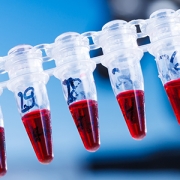Metagenomic testing for diagnosis and surveillance – two birds, one stone
A new approach for faster diagnosis of respiratory infections could also help monitor potential outbreaks of bacterial or viral diseases
A rapid genetic test for diagnosing respiratory infections is being rolled out to a large pilot group of intensive care units in England, following a successful trial at Guy’s and St Thomas’ hospitals in London. The test uses an approach called metagenomics to do so, but what is that, exactly, and what other applications could it have?
What is metagenomics?
Metagenomic approaches work by obtaining genomic sequences from all organisms present in a sample. In this case, human genomic sequences are removed from the dataset and the remainder is analysed for infectious organism sequences. This means that rather than having to ‘best guess’ and test a sample for a limited number of pathogens based on the clinical scenario and experience of clinicians and scientists, the test has the potential to identify any known infectious organism sequence in the sample. Analysis is limited to identifying pathogens known to science, but this is still many more than other types of testing.
This approach is much faster than other methods where microbiologists culture specimens over several days to produce conclusive results, during which time doctors may have to start treatment without a firm diagnosis.
Faster diagnosis of respiratory conditions
Initial results from the trial have shown that the test, which can return results within seven hours, can benefit almost 50% of patients with serious respiratory infections.
“It is vital that the sickest patients in our intensive care unit receive the right medication as quickly as possible,” said Guy’s and St Thomas’ Foundation Trust chief executive, Professor Ian Abbs. “This new genetic test can make that happen and we are delighted that we now have funding to ensure other intensive care units, and their patients, can also benefit.”
Pathogen genomics strategy – preventing new outbreaks
Another advantage to metagenomic strategies is that, because all organisms present in a sample are sequenced, the data it produces can help to track the spread of diseases, which, in turn, could help prevent new outbreaks.
Tests such as this could play a valuable part in implementing the new five-year Pathogen Genomics Strategy, recently announced by the UK Health Security Agency (UKHSA).
Clinical lead for the Genomics Programme at UKHSA, Dr Meera Chand said: “Pathogen genomics is an essential component of the world’s ability to respond quickly to infectious disease threats, whether by increasing the speed at which we can identify emerging pathogens or control outbreaks, or by improving our understanding of what treatments or vaccines might be effective.”
Building on lessons learned during the Covid-19 pandemic, the strategy aims to use genomics to look at more types of illness, such as tracking outbreaks of foodborne pathogens like salmonella or listeria, as well as monitoring antimicrobial resistance in infectious diseases such as tuberculosis.
UKHSA chief executive Professor Dame Jenny Harries said: “UK experts in the field of pathogen genomics made a vital contribution to the Covid-19 pandemic response and pathogen genomics remains central to the national and international effort to keep the public safe from many other types of infectious disease threats, from tuberculosis to mpox and avian influenza.”









